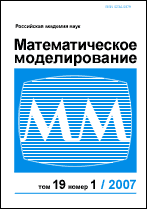|
This article is cited in 5 scientific papers (total in 5 papers)
Comparative analysis of the accuracy of three different schemes in the calculation of shock waves
O. A. Kovyrkinaab, A. A. Kurganovc, V. V. Ostapenkoab
a Novosibirsk State University, Novosibirsk, Russia
b Lavrentyev Institute of Hydrodynamics SB RAS, Novosibirsk, Russia
c Department of Mathematics, SUSTech International Center for Mathematics and
Guangdong Provincial Key Laboratory of Computational Science and Material Design,
Southern University of Science and Technology, Shenzhen, China
Abstract:
We perform a comparative accuracy study of the weighted essentially non-oscillatory (WENO), compact high-order weak approximation (CWA) and central-upwind (CU) schemes used to compute discontinuous solutions containing shocks propagating with variable velocity. We demonstrate that the accuracy of the formally high-order WENO and CU schemes, which are constructed using nonlinear flux correction mechanisms, reduces to the first order after the formation of shocks. This is done by measuring the integral convergence on intervals containing the region of shock wave influence. At the same time, the CWA scheme, which is designed to be high-order in the weak sense and does not rely on any nonlinear flux corrections, retains approximately the second order of integral convergence even in the regions of shock wave influence. As a result, in these areas, the accuracy of the WENO and CU schemes is significantly lower than the accuracy of the CWA scheme. We provide a theoretical justification of these numerical results.
Keywords:
weak solutions with shocks, numerical schemes, increased order of convergence.
Received: 14.12.2021
Revised: 27.04.2022
Accepted: 16.05.2022
Citation:
O. A. Kovyrkina, A. A. Kurganov, V. V. Ostapenko, “Comparative analysis of the accuracy of three different schemes in the calculation of shock waves”, Mat. Model., 34:10 (2022), 43–64; Math. Models Comput. Simul., 15:3 (2023), 401–414
Linking options:
https://www.mathnet.ru/eng/mm4410 https://www.mathnet.ru/eng/mm/v34/i10/p43
|

| Statistics & downloads: |
| Abstract page: | 360 | | Full-text PDF : | 84 | | References: | 59 | | First page: | 16 |
|




 Contact us:
Contact us: Terms of Use
Terms of Use
 Registration to the website
Registration to the website Logotypes
Logotypes









 Citation in format
Citation in format 